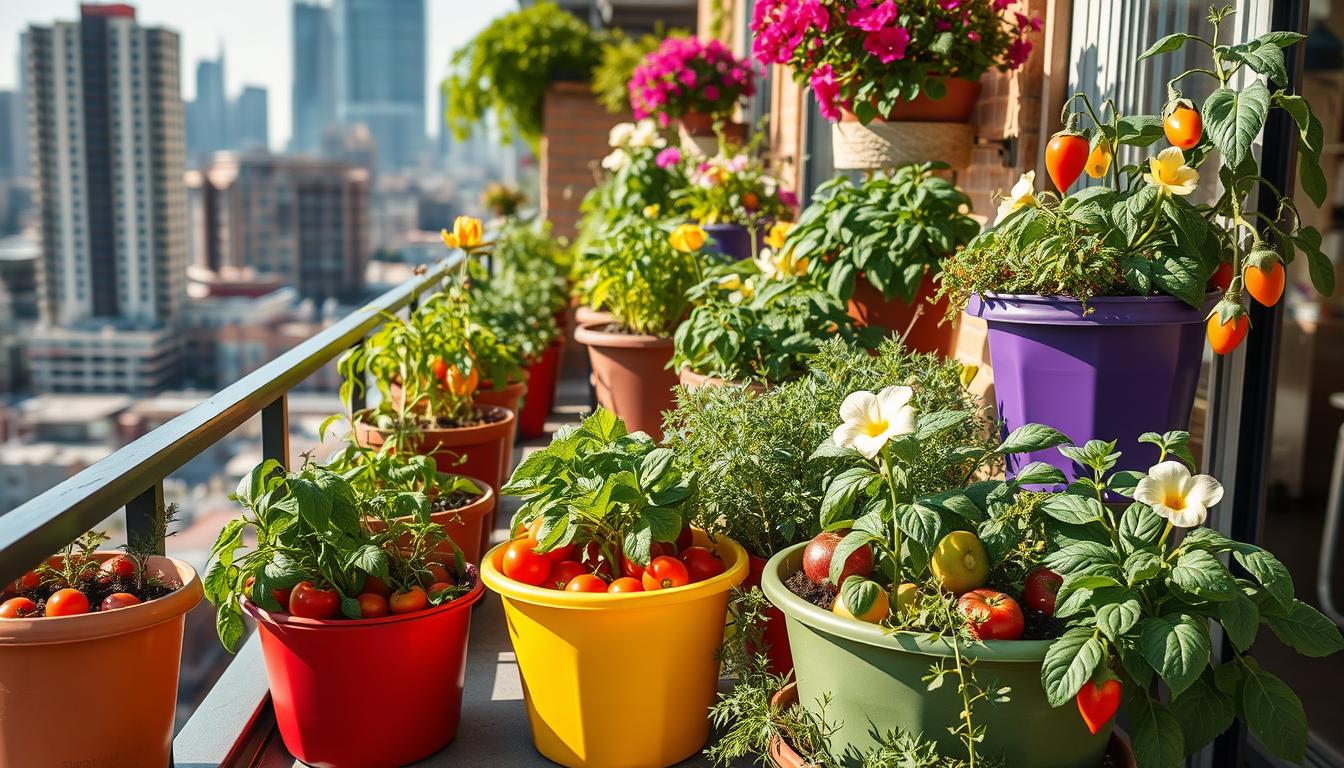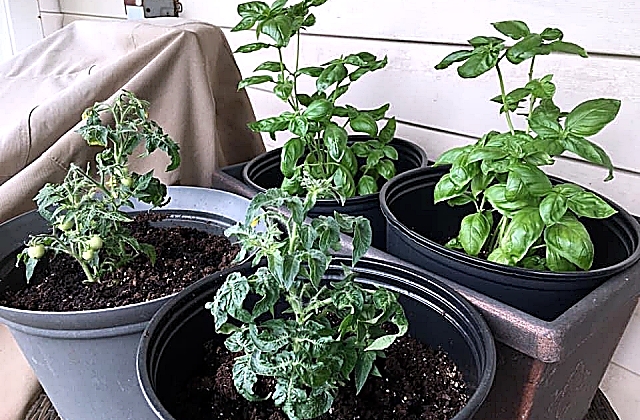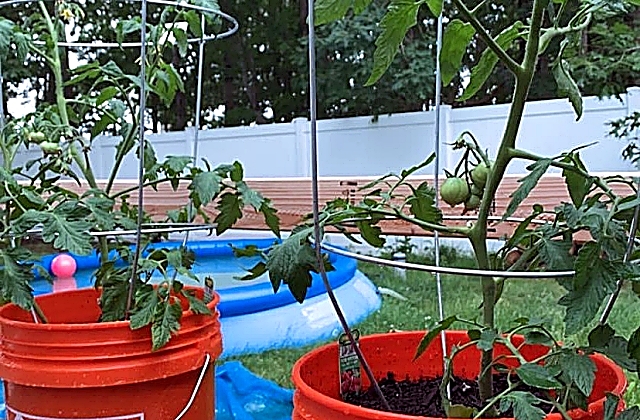Container Gardening: Tips for Planting in Containers
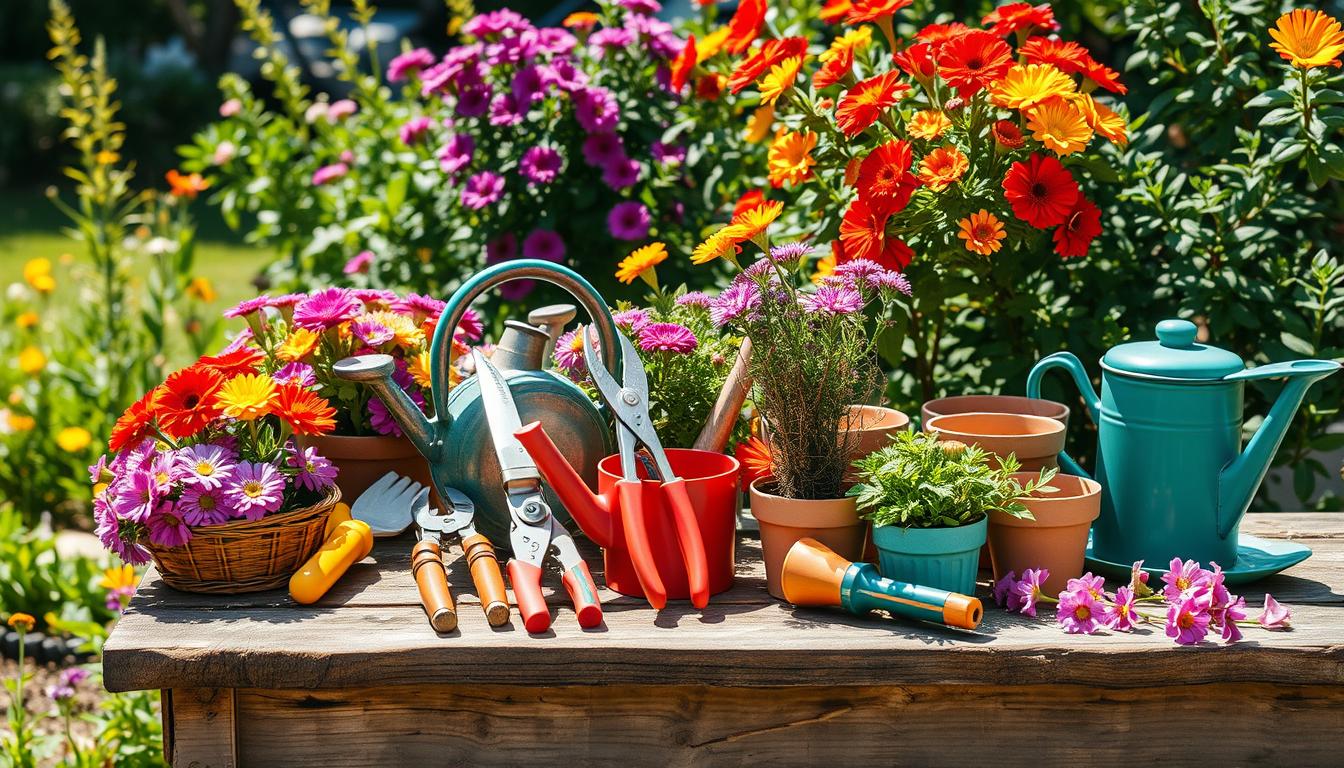
Container gardening lets you plant in flexible spots, avoid bad soil, and move plants with the seasons. It’s perfect for those with small spaces like patios or balconies. You can grow almost any plant in a container, from veggies to flowers and even dwarf fruit trees.
Choosing the right containers, soil, and how to water them is key. This makes your container garden successful.
Key Takeaways
- Container gardening offers flexibility and the ability to grow a variety of plants in limited spaces.
- Selecting the right containers, potting mix, and watering techniques are crucial for successful container gardening.
- Containers come in various materials, sizes, and drainage considerations to accommodate different plant needs.
- Proper placement of containers based on sun exposure and plant requirements is important.
- Consistent care, including fertilizing and pest management, is necessary for thriving container plants.
Introduction to Container Gardening
Container gardening is a fun and flexible way to grow plants. It’s perfect for small patios, balconies, or even just a windowsill. You can enjoy gardening in tight spaces by using portable containers. This lets you create beautiful container gardens, potted plants, patio gardens, and balcony gardens.
Benefits of Planting in Containers
Container gardening has many perks. You can place plants where they get the best sunlight. You also have control over the soil, using mixes made just for your plants. Plus, you can easily move your containers to protect your plants from bad weather or pests.
Types of Plants Suitable for Container Growing
- Vegetables, such as tomatoes, peppers, and leafy greens
- Annual and perennial flowers, including vibrant blooms and trailing vines
- Herbs, like basil, rosemary, and thyme
- Ornamental shrubs and small trees, including dwarf fruit trees
With the right container, soil, and care, many plants can do well in urban gardens. This lets you make a garden that’s lush, productive, and looks great.
“Container gardening offers an exciting and versatile approach to cultivating plants, whether you have a small patio, balcony, or even just a windowsill.”
Choosing the Right Containers
Choosing the right container is key to a successful container garden. Containers come in many materials, each with its own benefits and things to think about. Knowing what makes each material different helps you pick the best for your garden.
Material Options for Containers
Common materials for gardening containers include terracotta, glazed ceramic, stoneware, stone, wood, metal, plastic, and fabric. Each has its pros and cons:
- Terracotta pots let air in but need more watering.
- Glazed ceramic offers many colors and is strong but can be heavy and pricey.
- Wooden planters from cedar or redwood resist decay but get heavy over time.
- Plastic containers are cheap, strong, and light but don’t look as good as others.
- Metal planters can get too hot and plants may need more water.
Drainage Considerations
It’s crucial that all planters have good drainage holes to stop waterlogging and root rot. If a container lacks holes, you can drill them yourself. Good drainage lets water out while keeping soil moist for plants.
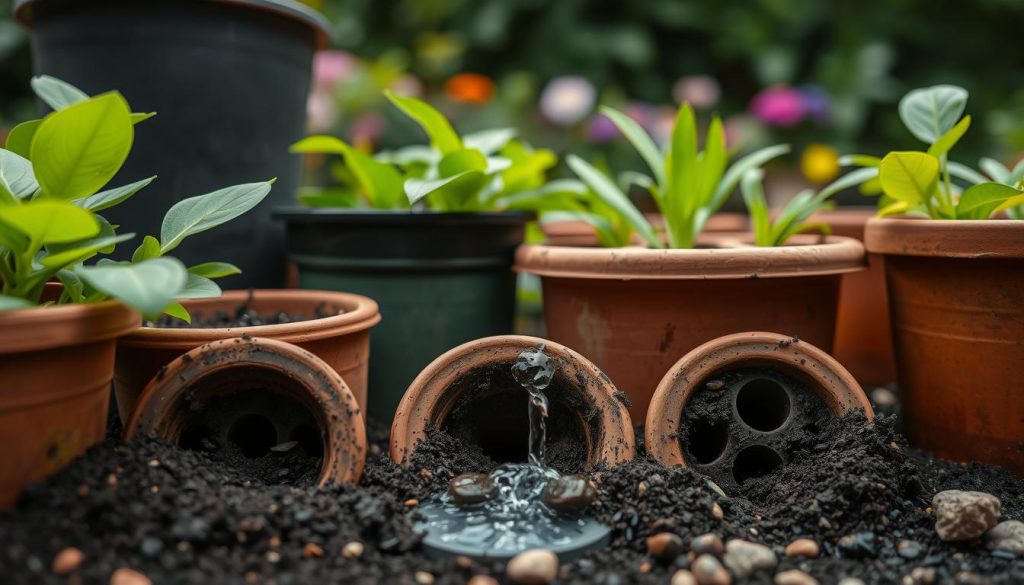
Think about the material and drainage when picking containers. This way, you can find the perfect ones for a healthy and beautiful container garden that fits your needs and tastes.
Selecting the Appropriate Container Size
Choosing the right size for your container is key to your plants’ health and success. The planter should be big enough for the plant’s mature size, including roots and spread. Deeper containers are better because they give roots more space to grow downward for water and cooler temperatures.
Experts say planters should be at least two inches bigger in diameter than the plant for best growth. Using a container too big can cause too much moisture, leading to root rot and plant death. Using one too small can stunt the plant’s growth and limit its ability to thrive.
Think about what your plants need when picking a container size. Plants like succulents and lettuce do well in shallow containers. But perennials and tall plants need deeper containers for their roots. Vegetables, especially those in a container-friendly kit, also need more space than herbs.
| Plant Type | Recommended Minimum Pot Size |
|---|---|
| Herbs (indoor) | 4 inches |
| Herbs (outdoor) | 6 inches or larger |
| Vegetables | Varies based on plant, larger than herbs |
When you’re moving or refreshing your plants, aim for a container that’s about two inches bigger in diameter. This helps avoid too much water and root rot, letting your plants keep growing and thriving.
Picking the right container size is crucial for your plants’ health and productivity. Matching the size to your plants ensures your container garden does well and gives you a great harvest or beautiful look.
Potting Soil and Soil Amendments
Choosing the right potting soil is key for your plants’ health and success in container gardens. Potting mixes are made to keep moisture in, drain well, and provide the nutrients plants need in containers.
Characteristics of a Good Potting Mix
A top-notch potting mix has perlite, compost, and peat moss. These mix together to make a light, airy soil that keeps moisture but doesn’t get too wet. Don’t use regular garden soil or topsoil in containers because they’re too heavy.
Many mixes come with pre-mixed fertilizers to feed your plants. But, always check the label and follow the instructions. Some plants need special mixes, like those for succulents or acid-loving plants like blueberries.
| Ingredient | Purpose |
|---|---|
| Perlite | Improves drainage and aeration |
| Compost | Provides organic matter and nutrients |
| Peat Moss | Retains moisture and improves texture |
| Vermiculite | Enhances water-holding capacity |
| Worm Castings | Adds beneficial microorganisms and nutrients |
If you’re using old potting soil, watch for pests or diseases. Adding fresh compost or worm castings can refresh the soil and give your plants a nutrient boost.
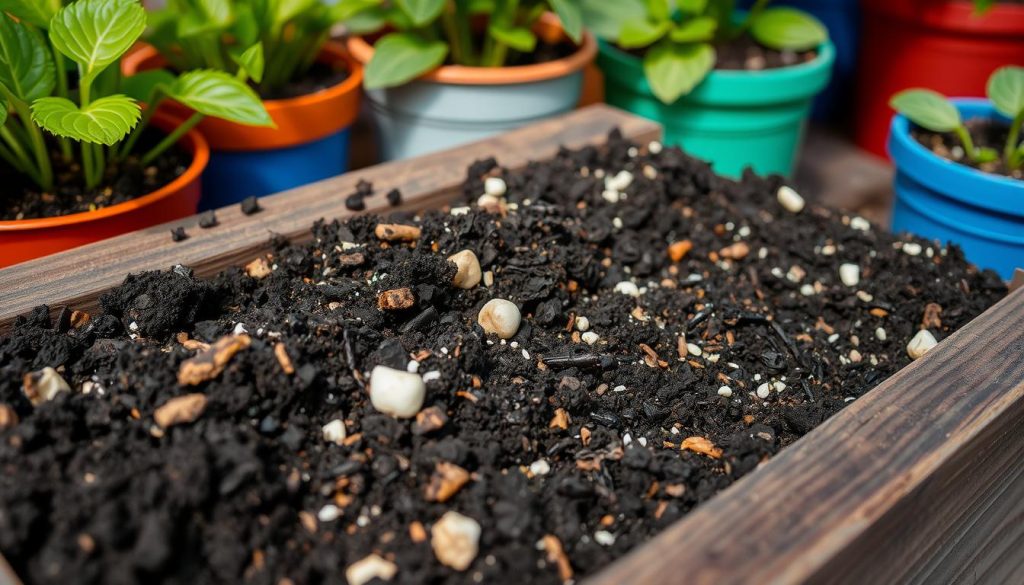
“Using the right potting mix is the foundation for a thriving container garden.”
Location and Sunlight Exposure
When you’re into container gardening, where you put your plants and how much sun they get are key. Getting enough sun is vital for your plants to stay healthy and grow well.
Most veggies like tomatoes, peppers, and squash need 6-8 hours of direct sunlight every day. These plants love the sun a lot. But, leaf and root veggies can handle some shade and only need 4-6 hours of sunlight. Herbs, especially those from the mint family, can even grow well in not much sunlight.
To make sure your plants get enough sun exposure, watch the microclimate around your containers. South-facing walls can be too hot for some plants but great for others. Using raised containers or special stands can help keep the soil cool and prevent it from getting too hot.
| Sunlight Requirement | Daily Sunlight Hours | Examples of Plants |
|---|---|---|
| Full Sun | 8+ hours | Tomatoes, peppers, eggplants, squash |
| Partial Sun | 6 hours | Leaf and root vegetables |
| Partial Shade | 4 hours | Leaf and root vegetables |
| Full Shade | Less than 2 hours | Shade-loving plants |
Keep an eye on your container location as the season goes on. The sun moves and gets stronger or weaker. Knowing what your plants need and the conditions in your garden lets you give them the right amount of sun exposure. This helps them grow and thrive.
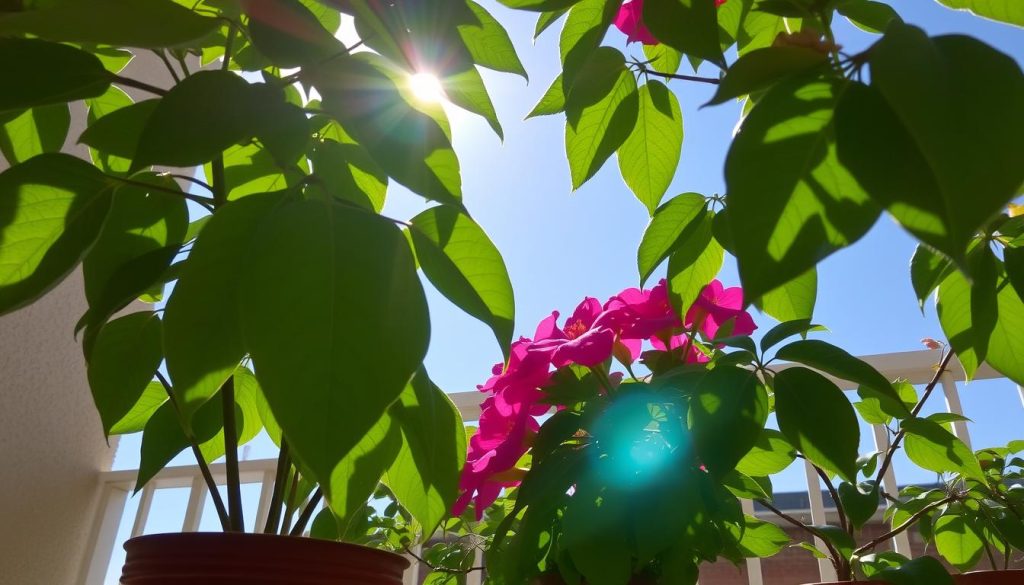
Watering Techniques for Container Gardens
Proper watering is key for your container garden’s success. The soil in containers dries out fast because it’s smaller. Check your containers daily to see if the soil feels dry an inch down. Water when it’s dry, making sure the water goes deep into the soil and drains well.
The amount you need to water changes with the season, the type of container, and how much sun it gets. You might need to water every day in the summer or on windy days. In winter, take out any saucers or trays to avoid too much water.
Signs of Over or Under-Watering
Watch for signs that your plants are getting too much or too little water. Too much water can cause yellow leaves, wilting, and root rot. Too little water leads to wilting, dry leaves, and slow growth. Keep an eye on your plants and adjust your watering as needed to keep them healthy.
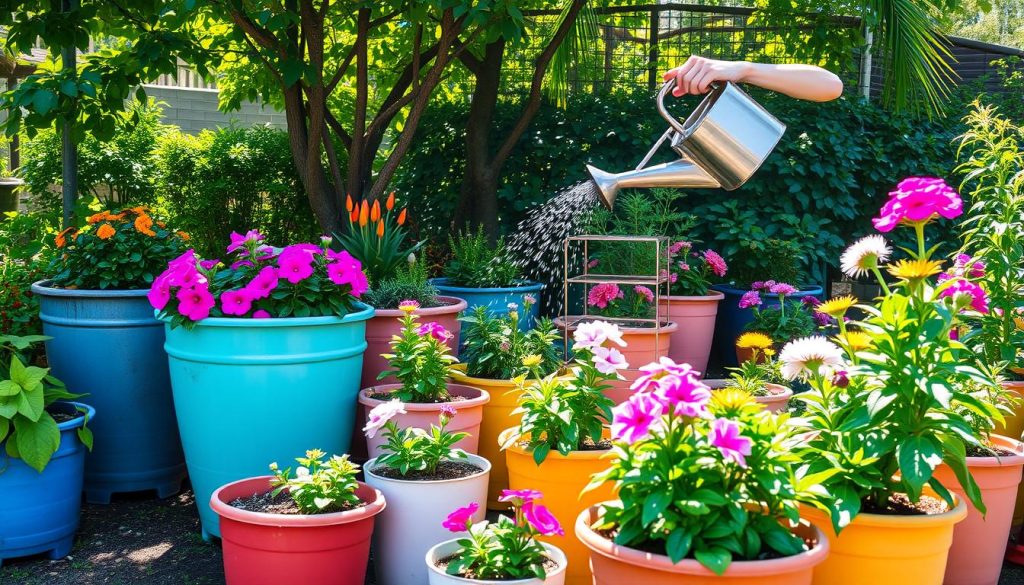
“Watering is the most critical component of container gardening. Get it right, and your plants will thrive; get it wrong, and they’ll struggle or even perish.”
Finding the right balance in watering is crucial for a successful container garden. Pay attention to your plants and adjust your watering based on their needs. This way, your garden will stay healthy and look great all season.
Fertilizing Container Plants
Keeping your container plants healthy often means fertilizing them regularly but lightly. This replenishes the nutrients lost when you water them often. There are two main ways to fertilize your plants:
- Use a water-soluble fertilizer with each watering. This gives your plants a quick boost of nutrients right to their roots.
- Add a slow-release dry fertilizer to the soil. These fertilizers feed your plants over time, so you don’t have to fertilize as often.
Many potting mixes come with some fertilizer already mixed in. Always check the label and follow the instructions to avoid over-fertilizing. Organic options like fish emulsion or seaweed are great because they give a balanced diet to your plants and help the soil life.
| Fertilizer Type | Nutrient Delivery | Frequency of Application |
|---|---|---|
| Water-soluble (liquid) | Immediate | Every 2-4 weeks |
| Slow-release (dry granules) | Gradual over time | Every 2-3 months |
Watch your plants closely and change your fertilizing plan if needed. Some plants need more food, especially if they’re growing fast or making lots of flowers or fruits. By keeping an eye on your plants’ needs, you help them grow well and reach their best.
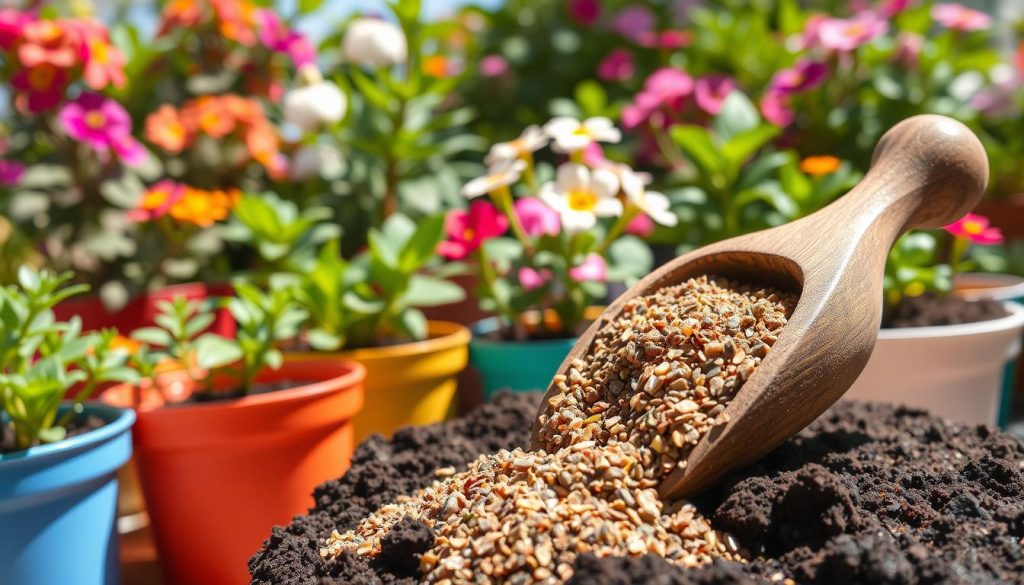
“Proper fertilization is key to the success of any container garden. The right balance of nutrients can make all the difference in the health and productivity of your plants.”
planting in containers
Container gardening requires careful planning to look good and use space well. Think about how big each plant will get and place them in the container for a balanced look.
Begin by putting the tallest plants in the middle or back of the container. These can be veggies like tomatoes, eggplant, or peppers that need big pots, at least 5 gallons. Then, add lower-growing plants like peas, lettuce, or green onions around them, which do well in 3-gallon pots.
Finish by letting trailing plants like vines or cascading herbs hang over the edges. This adds a soft touch to your garden.
When moving plants to containers, be gentle with their roots. Water them well after moving to help them settle. With the right setup and care, your container garden will thrive and brighten up any area.
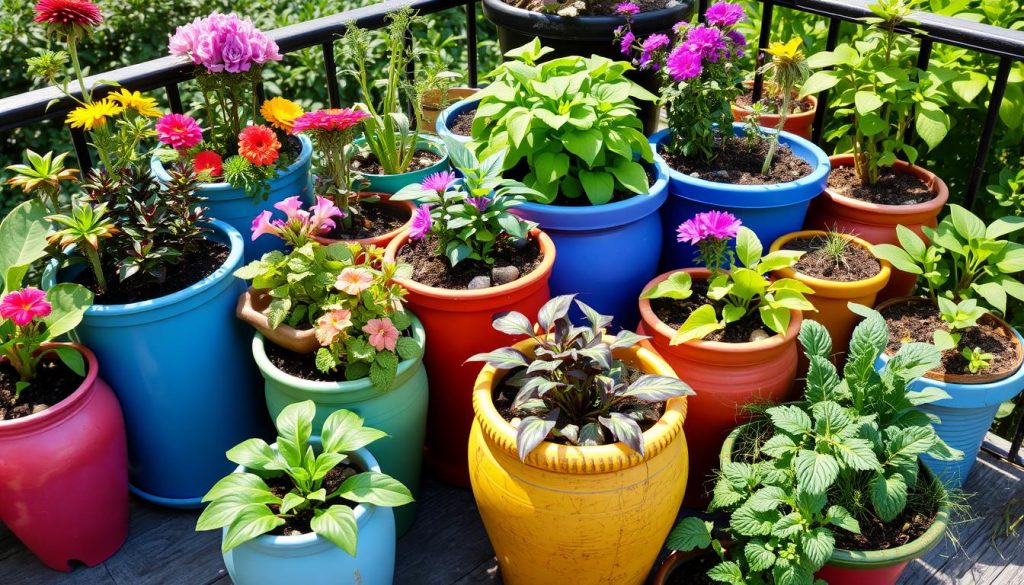
- 10″ to 12″ pot can hold 3-4 plants
- 14″ to 16″ pot can hold 5-7 plants
- 16″ to 20″ pot can hold 6-9 plants
Plan your container garden well to make a beautiful and productive spot, even in small areas. Pick compact or bushy veggies for container planting. Enjoy the big harvest from your potting plants and transplanting into containers.
Pest and Disease Management
Keeping a container garden healthy means watching out for pests and diseases. Common problems like aphids, spider mites, powdery mildew, and root rot can affect even the best cared-for plants. It’s important to check on your plants often and act fast when needed.
Using organic pest control is a great way to fight pests in container gardens. Insecticidal soap, neem oil, and other natural products can safely get rid of pests. Also, making sure your plants get the right amount of water, drainage, and air helps prevent diseases.
Sometimes, you might need to use physical barriers to protect your plants. Covering or caging your containers can keep out bigger pests like birds or squirrels. Checking your plants regularly helps you catch problems early.
By being careful and using organic pest control and good gardening habits, you can keep pests and diseases away from your container garden. Remember, a healthy garden starts with preventing diseases and managing pests well.
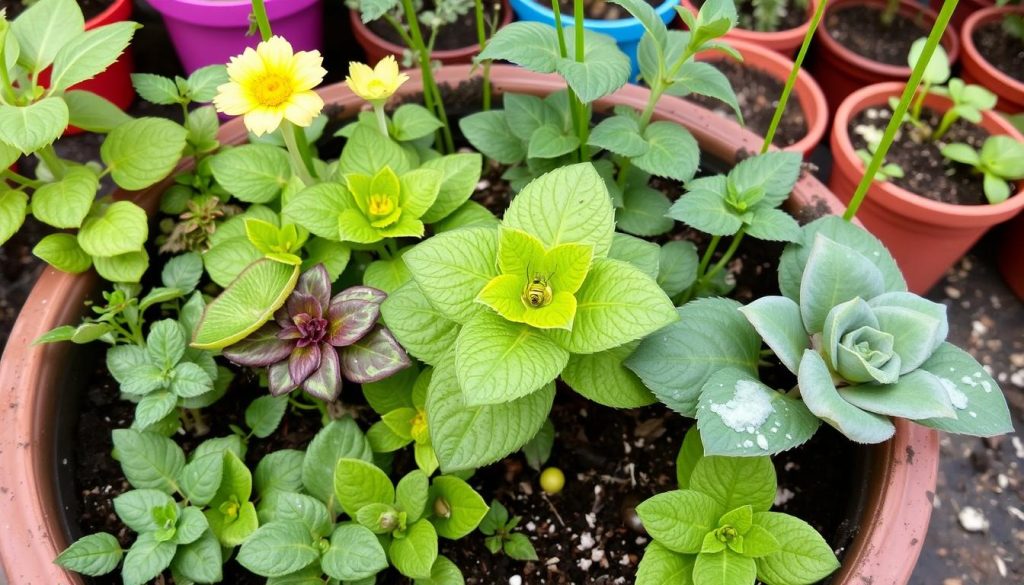
“A stitch in time saves nine – regular monitoring of your container plants is key to preventing and managing pest and disease issues.” – Jane Doe, Master Gardener
Dealing with container plant diseases and container garden pests can be tough, but you can beat it. With the right steps and organic pest control methods, you’ll have a beautiful, healthy container garden all season.
Pruning and Grooming Container Plants
Keeping your container plants healthy and looking great means you need to prune and groom them regularly. You should deadhead spent flowers, trim back leggy stems, and remove any damaged or sick leaves. The way you prune will depend on the type of plant you have.
Techniques for Pruning Different Plant Types
For herbs, you should prune them lightly and often. This helps them grow bushy and compact. Just cut off the flower buds or trim the stems a bit to stop them from getting too long.
Woody plants like shrubs or small trees need more careful pruning. Remove any dead, damaged, or branches that cross each other. This keeps the plant looking the way you want it to and at the right size.
When you’re pruning, always use clean, sharp tools to avoid hurting your plants. Cut just above an outward-facing bud or leaf node to help new growth. Clean your tools often to stop diseases from spreading.
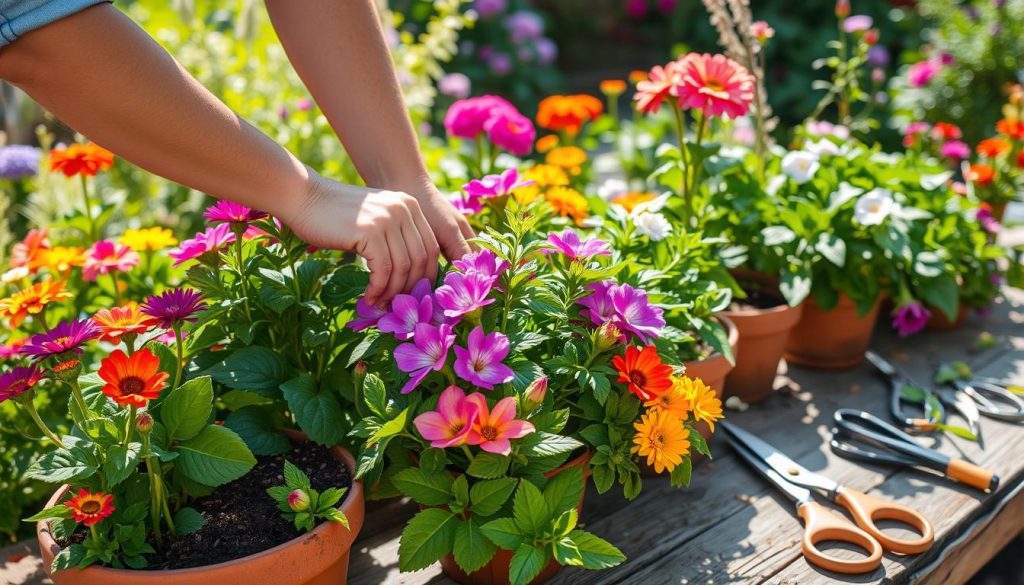
Grooming your container plants also helps them look their best. Deadheading spent flowers and trimming potted plants encourages more blooms and keeps the season going longer. Regular container plant grooming is an easy way to keep your outdoor space looking great.
| Plant Type | Pruning Technique | Frequency |
|---|---|---|
| Herbs | Light, frequent pruning | Every 2-3 weeks |
| Shrubs and Small Trees | Selective, structural pruning | Once or twice per year |
| Flowering Annuals and Perennials | Deadheading spent flowers | Throughout the growing season |
Overwintering Container Plants
For gardeners who want to keep their plants year-round, overwintering potted plants is key. It’s about getting plants ready for less light and drier air before winter hits. This process, called “hardening off,” helps plants adjust and prevents shock.
How you protect your plants depends on their cold hardiness. You might move them to a greenhouse, cold frame, garage, or basement. Insulating the roots and cutting back on water helps too.
If your plants can handle your area’s cold, try putting the pot in an unheated garage or burying it in the ground. Big pots protect roots better than small ones. Putting pots together also helps keep them warm.
Adding mulch on top of containers helps keep them warm. Picking cold-hardy container plants is crucial for making it through winter. In very cold places, annuals and perennials might only last a year.
With the right care, your overwintering potted plants can last for many years. Protecting your plants from winter keeps your container garden looking great season after season.
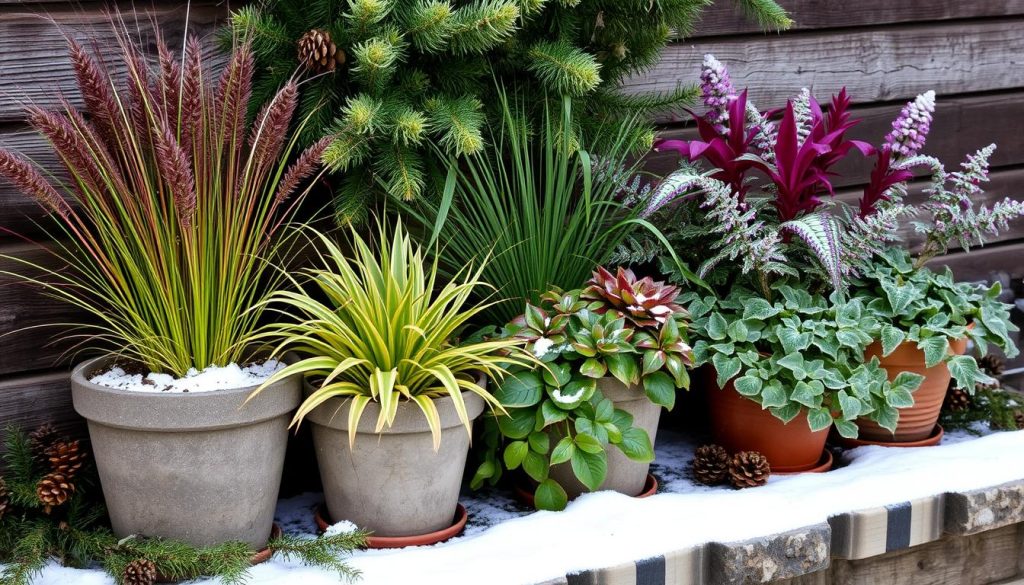
“Overwintering container plants is a game-changer for gardeners who want to maximize the return on their investment in potted plants.”
Tips for Overwintering Container Plants
- Gradually acclimate plants to reduced light and drier air before winter
- Move containers to a protected location, such as a greenhouse or garage
- Insulate roots and reduce watering to help plants survive the cold
- Choose cold-hardy container plants for best overwintering success
- Cover containers with mulch for extra insulation during winter
- Group containers together and bury pots in the ground for added protection
| Overwintering Technique | Best for Plant Hardiness | Potential Challenges |
|---|---|---|
| Unheated garage or basement | Plants hardy to your zone or one zone hardier | Limited space, potential for drying out |
| Burying pots in the ground | Hardy plants in cold climates | Potential for rodent damage, heavy lifting |
| Greenhouse or cold frame | Wide range of container plants | Access and maintenance requirements |
Repotting and Refreshing Soil
Keeping a container garden alive means checking on the soil now and then. Over time, the soil can lose important nutrients and become hard for plants to grow well in. Luckily, container plant repotting and container soil replacement are easy tasks. They can make your potted plants look great again.
Signs you should refresh the soil include if the container dries out too fast or if water doesn’t drain well. Also, if you see roots circling or coming out of the drainage holes, it’s time to act.
For rejuvenating potting soil, you have a few choices. For plants that live only one season, just add a fresh layer of good potting mix at the start. But if you have perennials staying in the same pot for years, you’ll need to repot them more thoroughly.
- Gently remove the plant from its container, taking care not to damage the roots.
- Trim any circling or overly dense roots to encourage new, healthy growth.
- Select a clean, slightly larger container and fill the bottom with a fresh potting mix.
- Replant the trimmed root ball and fill in around the sides, tamping down the soil lightly.
- Water the newly repotted plant thoroughly to help it settle in.
By taking the time to repot and refresh the soil in your container gardens, you’ll make sure your plants get the nutrients and oxygen they need. This way, they’ll thrive for many seasons.
“Healthy soil is the foundation for a vibrant container garden. Don’t be afraid to give your plants a fresh start by repotting and refreshing the potting mix.”
Container Garden Design and Arrangement
Creating a beautiful container garden means thinking about where and how you place different plants. Using a “thriller,” “filler,” and “spiller” plant mix is a great idea. This mix makes your garden look good and fills the container well.
Incorporating Thriller, Filler, and Spiller Plants
The thriller plant is the main attraction, standing tall and grabbing attention. Filler plants add color and texture around the thriller. Spiller plants flow over the container’s edges, making the design look soft and moving.
When picking plants for a mixed container garden, choose ones that like the same light, water, and food. This way, they’ll grow well together. It makes your potted plant arrangement look great and work well.
“The key to a successful container garden is striking the right balance between thriller, filler, and spiller plants.”
Here are some examples to show you what we mean:
- ‘Rustic Orange’ coleus has bright orange leaves that last until the first frost, perfect as a thriller.
- ‘Compact Hot Coral’ SunPatiens has small tangerine flowers, adding a pop of color as a filler.
- ‘Yellow Moon’ wishbone flower has lush green foliage that cascades down, acting as a spiller.
By carefully choosing these plant types, gardeners can make container garden designs that look amazing and last all season.
Maintenance and Care Routines
Keeping a container garden alive and healthy means giving it regular care and attention. This means watering, fertilizing, deadheading, and pruning as needed. It’s also key to watch for pests or diseases and act fast.
As seasons change, you might need to move your containers to get the best sunlight. For perennial plants, repotting and fresh soil can keep them growing strong.
Having a set maintenance schedule and watching for problems can make your container garden last. By doing these simple things, your potted plants will stay healthy and bright all season.
Watering Techniques for Container Gardens
Overwatering is the top reason container plants fail, causing them to grow poorly and have yellow leaves. In the summer, container plants might need water every day, especially in terra cotta pots that dry out quickly.
Water your container plants when the soil feels dry on top. Make sure water drains well from the pot to reach the roots. Water in the morning to keep leaves dry and avoid diseases.
Fertilizing and Pruning Container Plants
Container plants need a lot of food and do well with a slow-release fertilizer at planting. Then, use liquid fertilizer every two to three weeks until it gets cooler.
Trim container plants in midsummer to keep them from getting too big and stressed. Remove dead or sick leaves and flowers to keep them healthy and productive.
With a regular maintenance routine and quick action on problems, your container garden will do great all season and beyond.
Troubleshooting Common Issues
Container gardening can be tricky, but with careful attention, many problems are easy to fix. Issues like wilting plants, nutrient shortages, and pests can be solved by finding the cause. This is crucial for a healthy container garden.
One big issue is when plants don’t grow well, especially for those new to potted plants. Yellow leaves or not enough dark green foliage means there’s a problem. Plants that look leggy might not get enough sunlight exposure, a common problem in container gardening. Make sure your plants get at least 8 hours of direct sun each day.
Too much water can make plants look leggy and yellow, washing away important nutrients. Not enough water will cause wilting and slow growth. It’s important to check the soil often and water as needed for diagnosing container plant issues.
Choosing the wrong potting mix can also hurt plant growth. Heavy clay or low-quality mixes without good drainage can harm your plants. Using a top-notch, well-draining mix made for container gardening can really help.
By keeping an eye out and fixing problems fast, container gardeners can keep their plants healthy and strong. With some troubleshooting and the right changes, your container gardening can be a big success.
“The key to successful container gardening is being proactive and addressing problems as they arise. With keen observation and timely adjustments, you can overcome common challenges and enjoy a vibrant, thriving container garden.”
Conclusion
Container gardening is a great way for gardeners of all levels to enjoy the benefits of container gardening, even with limited space. By picking the right containers, soil, and plants, and taking good care of them, you can have a garden full of vegetables, herbs, or flowers. It’s a fun hobby that lets you be creative and connect with nature, even in cities or small places.
To make your container garden a success, think about the size of the container, the soil, how much sun it gets, and how often it needs water. By doing things right and solving common problems, you can have a beautiful garden that makes you happy and proud. It doesn’t matter if you’re new to gardening or have been doing it for years. Container gardening is a great way to enjoy plants and get the benefits of container gardening.
With the right knowledge and effort, container gardening can be very rewarding. It lets you create a beautiful garden, even in a small space. So, why not start today and see how much fun you can have with your own container garden?
